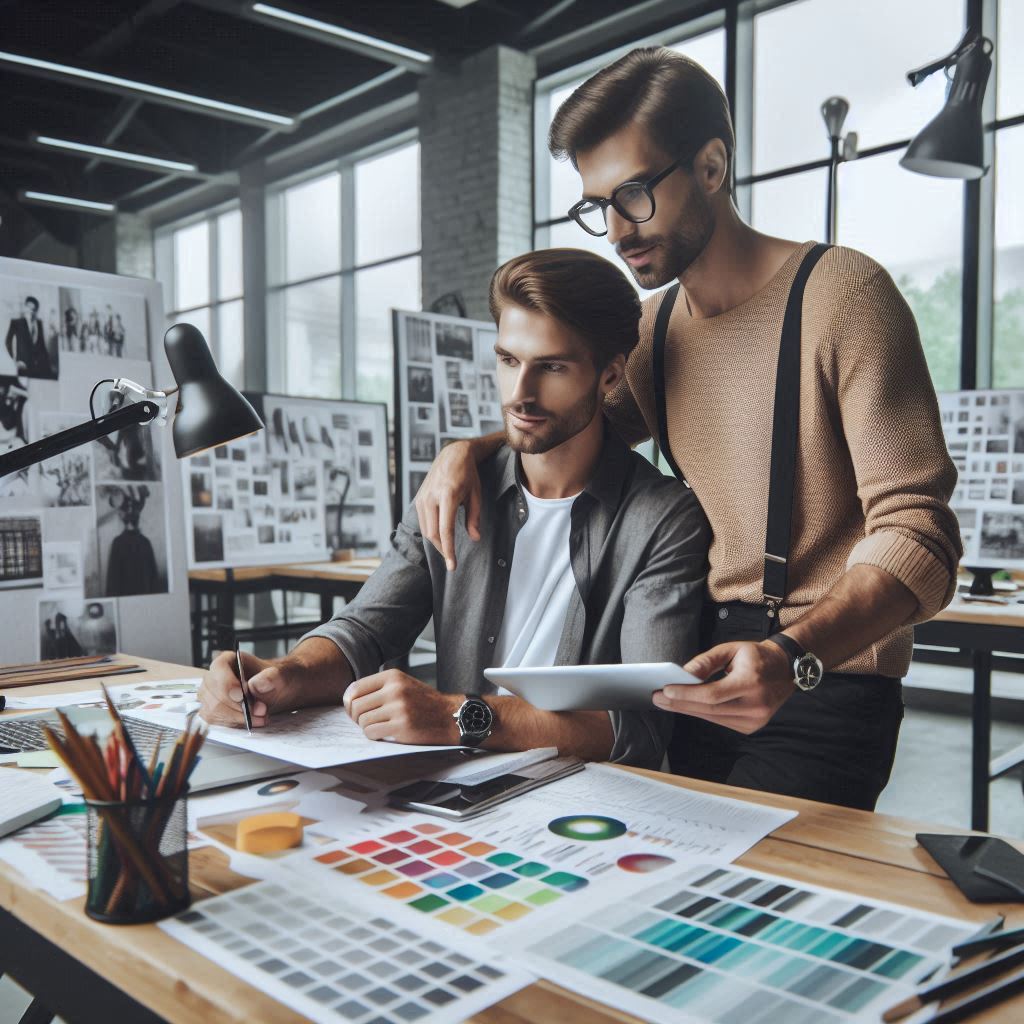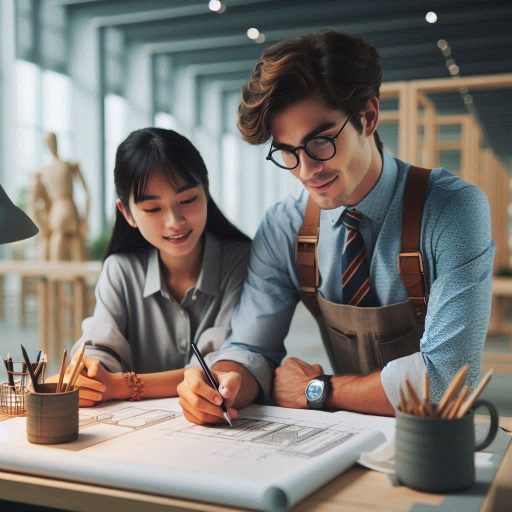Introduction
The demand for exhibition design continues to grow across various industries, driven by the need for impactful marketing strategies.
Companies increasingly recognize the value of captivating displays to attract audiences and showcase their products.
Effective exhibitions play a crucial role in branding, communication, and customer engagement.
Freelance designers offer unique advantages, including flexibility and a diverse range of creative perspectives.
They often bring specialized skills tailored to specific projects and have experience working across different sectors.
This variety can infuse fresh ideas into exhibition design, making displays stand out in a competitive landscape.
On the other hand, in-house designers possess a deep understanding of the company’s brand, culture, and goals.
They are more likely to align their designs with internal strategies and values.
This ongoing collaboration fosters a cohesive approach, ensuring that every exhibition resonates with the brand’s identity.
Ultimately, understanding the strengths and weaknesses of each option will help you make an informed decision.
By weighing the benefits of freelancers against the advantages of in-house designers, you can choose the path that best suits your exhibition’s objectives.
Making this choice wisely can enhance your exhibition’s impact, drive engagement, and contribute to your organization’s overall success.
Differences in Work Environment
When considering exhibition design, the work environment significantly affects how designers operate.
Freelance designers often work remotely or from their own studios.
This flexibility allows them to choose their workspace and schedule.
They can design in comfort, whether at home, a co-working space, or a coffee shop.
In contrast, in-house designers work within a specific company or organization.
They typically have a designated office space and a set routine.
This structured environment fosters collaboration with colleagues and immediate feedback from stakeholders.
The in-house setting encourages a strong team dynamic, where designers can brainstorm and share ideas readily.
Freelance designers work remotely or in their own studio
Freelancers enjoy a variety of clients and projects.
Each new project offers fresh challenges and opportunities for creativity.
However, this constant change can also lead to unpredictability in income and workload.
Freelancers must actively seek new clients and manage their time effectively to maintain a steady flow of work.
Freelance designers have the freedom to establish their own work hours.
This flexibility allows for a better work-life balance, accommodating personal commitments.
However, it also requires discipline and self-motivation to meet deadlines.
Freelancers must manage their own schedules and ensure they deliver high-quality work consistently.
In-house designers are part of a team in a specific company or organization
On the other hand, in-house designers benefit from job stability.
They usually receive a consistent salary and have a reliable workload.
This stability allows them to focus on long-term projects and build expertise within their organization.
In-house designers often develop a deeper understanding of their company’s brand and objectives.
In-house designers typically adhere to a standard 9-to-5 schedule.
This structure can provide a clear distinction between work and personal time.
However, it may limit flexibility and creativity for some individuals.
In-house designers might find themselves working on projects that don‘t excite them as much.
Collaboration varies significantly between the two environments.
Freelancers often work independently, which can lead to isolation.
They must be proactive in networking and maintaining client relationships.
In-house designers, however, collaborate regularly with various departments.
This teamwork fosters creativity and encourages diverse perspectives.
The differences in work environments between freelance and in-house exhibition designers significantly impact their roles.
Freelancers enjoy flexibility and variety but face unpredictability.
In-house designers benefit from stability and collaboration but may have less creative freedom.
Understanding these differences can help aspiring designers choose the right path for their careers.
Read: Best Tools and Software for Character Designers
Flexibility in Schedule
Freelancers: Setting Your Own Hours
Freelancers enjoy the autonomy of setting their own schedules.
This level of flexibility allows them to work during their most productive hours, whether that’s early in the morning or late at night.
They can structure their day in a way that maximizes their creativity and efficiency, leading to high-quality design work.
Moreover, freelancers can easily accommodate personal commitments and adapt their work hours to fit around important events or activities.
This level of control over their schedule can lead to a better work-life balance, ultimately increasing job satisfaction and overall well-being.
In-House Designers: Fixed Hours
On the other hand, in-house exhibition designers are typically bound by fixed working hours set by their employer.
They are required to adhere to company policies regarding work schedules, which may include specific start and end times, lunch breaks, and overtime requirements.
While working in-house offers a structured routine, it can limit the flexibility of designers in terms of when they work best.
This rigidity may not suit everyone’s natural workflow, potentially hindering creativity and productivity.
In-house designers must find ways to maintain their creative spark within the constraints of a predetermined schedule.
Choosing the Right Fit
When it comes to flexibility in schedule, freelancers clearly have the upper hand.
Their ability to set their own hours and tailor their workday to their preferences can result in a more efficient and fulfilling design process.
However, some designers may thrive in a more structured environment and appreciate the stability that in-house positions provide.
Ultimately, the decision between freelance and in-house exhibition design should be based on your personal work style and preferences.
Consider how important flexibility in schedule is to you and how it aligns with your professional goals.
By choosing the right fit, you can optimize your design workflow and produce outstanding results in the exhibition design industry.
Read: Ceramic Art: From Hobby to Professional Career
Project Variety
Freelancers
Freelancers enjoy a dynamic work environment where they can engage with diverse projects across various clients.
This variety allows them to explore different industries, styles, and creative approaches, keeping their work fresh and exciting.
Working with multiple clients not only enriches their portfolio but also expands their skill set and knowledge base.
Each project presents unique challenges and requires distinct solutions, pushing freelancers to continually learn and adapt.
This constant evolution enhances their versatility, making them more attractive to future clients who seek well-rounded professionals.
Freelancers also have the flexibility to choose projects that align with their interests and expertise.
They can pursue work that resonates with their personal values or passion projects that might otherwise be neglected in a traditional role.
This autonomy empowers them to curate their workload and choose assignments that ignite their creativity, leading to greater job satisfaction.
Moreover, each new project brings a fresh set of challenges and opportunities for growth.
Freelancers often find themselves in fast-paced environments where they must think on their feet, develop creative solutions, and deliver results quickly.
This agility not only sharpens their problem-solving skills but also enhances their ability to manage time effectively.
In-House Designers
In contrast, in-house designers typically focus on projects within a specific company’s niche or industry.
This concentration allows them to develop a deep understanding of the brand’s values, mission, and target audience, which significantly informs their design decisions.
They become intimately familiar with the brand’s voice, ensuring that their work consistently reflects its identity.
Working within the same industry enables in-house designers to specialize and become experts in their field.
They gain insights into market trends, competitor strategies, and consumer behavior, which allows them to craft more effective and relevant designs.
This expertise can lead to greater career advancement opportunities within the company, as they can be seen as vital contributors to the brand’s success.
In-house designers often benefit from a consistent workflow, which allows them to develop long-term strategies for exhibition design and other projects.
This stability fosters an environment where they can focus on building and refining their skills without the pressure of constantly seeking new clients.
They can invest time in developing cohesive branding and design strategies that align with the company’s long-term goals.
Ultimately, the choice between freelancing and working in-house boils down to personal preference and career goals.
Freelancers thrive on variety and relish the challenge of adapting to new projects, constantly expanding their horizons.
They enjoy the freedom to explore different avenues of creativity and the excitement of diverse client relationships.
On the other hand, in-house designers value the stability and deep expertise that come from focusing on a specific industry.
They appreciate the opportunity to build lasting relationships with colleagues and the ability to see their designs implemented over time.
Both paths offer unique opportunities for growth and creativity, each contributing to the vibrant landscape of exhibition design.
Read: How to Create Memorable Characters: Pro Tips
Communication with Clients
Freelancers interact directly with clients to understand their needs and vision
Freelance exhibition designers enjoy unique advantages when it comes to client communication.
This direct interaction allows them to grasp the client‘s needs, vision, and expectations firsthand.
By engaging directly with the client, freelancers can ensure that their design work aligns seamlessly with the client‘s goals for the exhibition.
This personalized approach often produces more successful outcomes.
The designer asks clarifying questions and gathers immediate feedback throughout the design process.
Freelancers also have the flexibility to tailor their communication style to fit each client’s preferences.
Whether clients prefer emails, phone calls, or face-to-face meetings, freelancers can adapt their approach accordingly.
This versatility helps establish a strong rapport and fosters trust, which can enhance the overall design experience.
Clients often appreciate this level of attention and responsiveness, which can result in a more collaborative and satisfying partnership.
Freelancers often demonstrate agility, allowing them to pivot quickly based on client feedback.
They adapt to changing circumstances, ensuring the final product meets or exceeds expectations.
In-house designers collaborate with internal teams for project coordination and feedback
In contrast, in-house exhibition designers operate within a different framework.
They typically collaborate closely with various internal teams for project coordination and feedback.
This collaborative model involves multiple stakeholders within the organization, including marketing teams, sales teams, and senior management.
While this setup can provide valuable insights and input from diverse departments, it often leads to longer decision-making processes.
The necessity to consult with various internal players can slow down the pace of design development and introduce complexities that freelancers may not face.
Moreover, in-house designers must navigate the feedback and requirements of different departments, which can sometimes create creative limitations.
The need to align the design with the opinions and goals of various stakeholders may hinder the designer‘s ability to fully capture the client‘s original vision.
This indirect communication with clients can lead to misunderstandings and misinterpretations, further complicating the design process.
Delays may arise as designers work to reconcile conflicting feedback, and the original creative intent can sometimes get lost in the shuffle.
Effective communication with clients is a fundamental aspect of successful exhibition design.
Freelancers benefit from direct interaction with clients, which allows for a more personalized and tailored approach to their work.
This direct line of communication fosters a deeper understanding of the client‘s objectives, leading to designs that are more aligned with their vision.
Read: Ceramic Art Exhibitions to Visit in 2024

Creative Control
When it comes to exhibition design, creative control plays a crucial role.
This factor can significantly impact the final output.
Let‘s explore how freelancers and in-house designers differ in their creative freedom.
Freelancers: Full Creative Control
- Independent Vision: Freelancers enjoy the freedom to express their unique design perspectives.
They create concepts that resonate with their individual style. - Flexible Design Choices: Freelancers make decisions on materials, layouts, and themes without external constraints.
This flexibility allows for innovative and original designs. - Personalized Client Collaboration: Freelancers collaborate directly with clients, understanding their vision and preferences.
This direct communication fosters creativity and leads to tailored solutions. - Diverse Project Experiences: Working on various projects helps freelancers refine their design skills.
Exposure to different industries enhances their creative toolkit. - Creative Risks: Freelancers can take creative risks without fear of corporate backlash.
This willingness to experiment can lead to groundbreaking designs.
In-House Designers: Guided Creativity
- Adherence to Brand Guidelines: In-house designers must follow established brand standards.
These guidelines ensure consistency but can limit creative expression. - Collaboration with Multiple Departments: In-house designers often work with marketing, sales, and product teams.
This collaboration can dilute individual creative input as they align with broader company goals. - Project Scope Limitations: In-house projects are usually predefined and constrained by company objectives.
This limitation can restrict innovative design approaches. - Feedback Loops: In-house designers face multiple feedback loops from various stakeholders.
While this can enhance designs, it may stifle initial creative ideas. - Risk Aversion: In-house teams may avoid bold design choices to minimize risk.
This cautious approach can lead to conventional and less innovative outcomes.
The difference in creative control between freelancers and in-house designers is striking.
Freelancers benefit from independence and the freedom to innovate.
Their ability to take creative risks often results in fresh and engaging designs.
In contrast, in-house designers operate within structured frameworks.
Their work aligns closely with company branding and objectives.
While this can lead to consistency, it may limit originality.
Understanding these dynamics is crucial for companies seeking exhibition design.
Depending on their needs, they can choose the right design approach to achieve their goals.
Job Security and Stability
When considering exhibition design, the choice between freelance and in-house roles significantly impacts job security and stability.
Here‘s a closer look at these differences.
Transform Your Career Today
Unlock a personalized career strategy that drives real results. Get tailored advice and a roadmap designed just for you.
Start NowFreelance Face: Uncertainty in Project
Freelancers often face various challenges regarding job security.
Here are key factors to consider:
- Project Availability: Freelancers must continually search for new projects.
This constant need for new clients can be stressful. - Income Variability: Their income fluctuates based on project availability.
A slow month can mean a drastic reduction in earnings. - Lack of Benefits: Freelancers usually do not receive employee benefits.
This absence of health insurance, retirement plans, and paid time off adds financial strain. - Client Dependency: Freelancers rely heavily on client relationships.
A loss of a major client can create immediate financial challenges. - Economic Factors: Market conditions directly influence the number of available projects.
Economic downturns can significantly decrease project availability. - Self-Promotion Requirements: Freelancers must actively market their services.
This effort takes time and may detract from design work.
While freelancing offers flexibility, it also brings significant uncertainty.
Designers often experience anxiety related to income and project availability.
In-House Designers: Security and Benefits
In contrast, in-house designers enjoy a more stable working environment.
Here are the benefits of in-house positions:
- Stable Salary: In-house designers receive a consistent paycheck.
This stability allows for better financial planning. - Employee Benefits: In-house roles typically include benefits like health insurance, retirement plans, and paid leave.
These perks provide additional financial security. - Job Security: Companies value in-house designers for their specialized knowledge.
This relationship often leads to greater job stability. - Career Advancement: In-house positions often provide clear paths for career growth.
Designers can move into senior roles with increased responsibilities and pay. - Collaborative Environment: Working within a team fosters collaboration and support.
This environment can enhance creativity and reduce isolation. - Consistent Workflow: In-house designers usually work on ongoing projects.
This steady workload reduces the stress of finding new clients.
In-house positions provide not just financial security but also a supportive work culture.
Designers can focus on creativity without the constant worry of job hunting.
The choice between freelance and in-house exhibition design greatly affects job security and stability.
Freelancers face uncertainty and fluctuating income, while in-house designers benefit from a steady salary and employee perks.
Ultimately, understanding these differences helps designers make informed career choices that align with their financial and professional goals.
Find Out More: Understanding Lighting Design for Film and TV
Networking Opportunities
Freelance Designers: Expanding Your Network
Freelancers in exhibition design benefit from diverse networking opportunities.
They often work with various clients across multiple industries.
This exposure helps freelancers connect with different professionals, including:
- Clients: Building relationships with various companies enhances future project opportunities.
- Vendors: Collaborating with suppliers and contractors fosters strong partnerships.
- Industry Peers: Meeting fellow designers allows for knowledge sharing and inspiration.
- Event Organizers: Networking with organizers can lead to exclusive design opportunities.
Freelancers attend industry events, trade shows, and conferences.
These occasions enable them to meet potential clients and collaborators.
Active participation in these events strengthens their professional presence.
Additionally, freelancers can join online communities and forums, expanding their reach beyond geographical limits.
Freelancers also have the flexibility to pursue diverse projects.
Each project introduces them to new clients and collaborators.
This continuous interaction builds a rich, varied network.
Over time, freelancers can become well-known figures in the exhibition design field.
In-House Designers: Limited Networking Scope
In-house designers typically face more restricted networking opportunities.
They often work solely within their organization.
This limitation can hinder their exposure to external industry connections.
Some challenges in networking for in-house designers include:
- Focus on Internal Projects: In-house designers prioritize company projects over networking.
- Limited External Contact: They interact mainly with colleagues, reducing exposure to new ideas and trends.
- Fewer Industry Events: In-house roles may not involve attending industry events as frequently.
Although in-house designers might develop strong relationships within their companies, they often miss external networking benefits.
These internal connections can provide support and collaboration but limit growth.
Strategies for In-House Designers
In-house designers can still enhance their networking efforts.
They can pursue several strategies to expand their connections:
- Attend Industry Events: Seek opportunities to attend exhibitions, seminars, and workshops.
- Join Professional Organizations: Become a member of design associations to meet industry professionals.
- Engage on Social Media: Utilize platforms like LinkedIn to connect with other designers and industry leaders.
By taking these steps, in-house designers can broaden their professional circle.
However, the inherent limitations of in-house positions often restrict their networking potential.
Freelancers have significant advantages in networking compared to in-house designers.
The diverse opportunities available to freelancers allow them to build a rich network of connections.
In contrast, in-house designers face challenges that limit their exposure to the wider industry.
Ultimately, the choice between freelance and in-house work can greatly influence networking opportunities in exhibition design.
Conclusion
Both freelance and in-house exhibition design offer unique advantages and challenges that cater to different career aspirations.
Freelancers enjoy significant flexibility, allowing them to set their own schedules and choose projects that align with their interests.
This variety can lead to a rich and diverse portfolio, showcasing a wide range of styles and concepts.
However, freelancing often comes with income instability, as work can fluctuate.
In-house designers enjoy job security and a steady workflow.
They often work on ongoing projects, which deepen their understanding of a brand’s identity.
They enjoy collaboration with a dedicated team, which can foster creativity and lead to innovative ideas.
When deciding between freelance and in-house work, reflect on your career goals and personal preferences.
Consider whether you value flexibility and independence or prefer the structure and security of a full-time position.
Evaluate how much creative freedom you seek and how important job security is for you.
Ultimately, weigh the pros and cons carefully to make the best choice for your future in exhibition design.
Your decision should align with your aspirations and lifestyle, ensuring you find fulfillment in your work.




